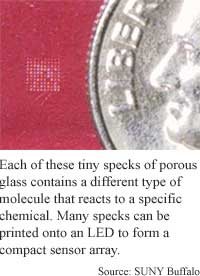
Porous
glass makes minuscule sensor
By
Kimberly Patch,
Technology Research NewsBeing able to sense the presence of small amounts of chemicals is useful in many ways. Although humans have largely lost any natural ability to do so, many animals use their senses of smell to communicate and glean information about their environments like who has been where, when.
A group of researchers from the State University of New York at Buffalo have made a type of sensor that uses light to detect chemicals in a sample, and can cram many sensors into a space smaller than a thumbtack. "[We] can fit a large number of sensor elements into a small footprint," said Frank Bright, a professor of chemistry at the university.
The scheme could eventually allow for sensor arrays that simultaneously detect 100 or more different substances in a single sample.
The sensor consists of a light source and xerogel, a type of glass that contains chemically-sensitive molecules like protein or dye, but is porous enough to allow chemicals from the environment to diffuse in and interact with the sensitive molecules. Each protein or dye can react with a specific chemical. These interactions change the way the protein or dye emits light.
Once the sensor array is exposed, the light source excites the chemically-sensitive molecules so that they emit light, or fluoresce. The light passes through a filter and goes on to a detector that is something like a very sensitive TV camera. "When we collect the image... we see an... array of sensor elements, each responsive to a given analyte," or environmental chemical, said Bright.
The researchers' prototype devices used molecules that sensed the oxygen content and hydrogen ion concentration, or pH, of a liquid sample.
To make the arrays, the researchers first combined the gel with the chemically-sensitive molecules, then used a pin printer to print each sensor element onto a glass slide. "When the gel material is liquid we mix in the sensing chemistry and the sensing chemistry becomes dispersed within the gel material. Once the xerogel is formed, the sensing chemistry is entrapped," said Bright.
Pin printers use metallic pins to print spots of liquid onto a surface; the researchers printed the xerogel at the rate of about one sensor per second.
In the past, the group attempted to make sensors by depositing xerogel into tiny wells, but found that printing them was much easier, said Bright. "Filling those small wells was a pain... and we knew we needed to develop a better way," he said.
The key to making the arrays was realizing that they could be printed, said Bright. "The main breakthrough was to recognize that these pin printers can be used to print these... gel materials and form the sensor elements," he said.
Each sensor element measures 100 microns in diameter and is about two microns thick. A micron is one thousandth of a millimeter. The xerogel pores are a few tens of nanometers in diameter, which is more than 100 times smaller than the girth of an E. coli bacterium. A nanometer is one millionth of a millimeter. The sensing elements are reusable, according to Bright.
One advantage of the scheme is the sensing chemistry can be printed right on a light source like an light emitting diode (LED), said Bright. "This makes the whole device much smaller and much more robust," he said. The researchers are currently working on doing this, according to Bright.
The scheme could eventually be used in a hospital where a doctor might take a single, small blood sample and place it on the sensor array, said Bright. "The idea now is that instead of getting a single reading for, say, glucose, our array would allow one to get 100 or more analytes in the sample at the same time," said Bright.
The key challenge now is to find more chemically sensitive materials that can work within the xerogels, said Bright. "The next step for us is to extend the system to more analytes and to gain further understanding of the chemistry that occurs within the small xerogels. We need to always have an understanding of what's going on in the xerogels to use them properly," he said.
The researchers are aiming to detect drugs, agricultural products like pesticides, steroids and antibiotics, and environmental pollutants like polycyclic aromatic hydrocarbons, said Bright. "Our hope is to develop the sensor array where there may be, say, 100 sensor elements designed to detect 100 different chemical species in a single sample simultaneously," he said.
Bright's research colleague was Jeong Cho. The research is slated to be published in the journal Analytical Chemistry in March. The research was funded by the National Science Foundation (NSF).
Timeline: unknown
Funding: Government
TRN Categories: Biotechnology
Story Type: News
Related Elements: Technical paper, "Pin-Printed Chemical Sensor Arrays for Simultaneous Multianalyte Quantification," slated for publication in Analytical Chemistry in March.
Advertisements:
April 3/10, 2002
Page One
Electron waves compute
Software orchestrates Web presentations
Porous glass makes minuscule sensor
Internet map improves models
Magnets channel biomatter

News:
Research News Roundup
Research Watch blog
Features:
View from the High Ground Q&A
How It Works
RSS Feeds:
News
Ad links:
Buy an ad link
| Advertisements:
|
 |
Ad links: Clear History
Buy an ad link
|
TRN
Newswire and Headline Feeds for Web sites
|
© Copyright Technology Research News, LLC 2000-2006. All rights reserved.